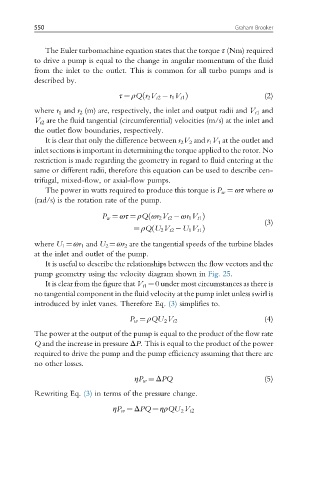Page 557 - Handbook of Biomechatronics
P. 557
550 Graham Brooker
The Euler turbomachine equation states that the torque τ (Nm) required
to drive a pump is equal to the change in angular momentum of the fluid
from the inlet to the outlet. This is common for all turbo pumps and is
described by.
ð
τ ¼ ρQr 2 V t2 r 1 V t1 Þ (2)
where r 1 and r 2 (m) are, respectively, the inlet and output radii and V t1 and
V t2 are the fluid tangential (circumferential) velocities (m/s) at the inlet and
the outlet flow boundaries, respectively.
It is clear that only the difference between r 2 V 2 and r 1 V 1 at the outlet and
inlet sections is important in determining the torque applied to the rotor. No
restriction is made regarding the geometry in regard to fluid entering at the
same or different radii, therefore this equation can be used to describe cen-
trifugal, mixed-flow, or axial-flow pumps.
The power in watts required to produce this torque is P w ¼ ωτ where ω
(rad/s) is the rotation rate of the pump.
ð
P w ¼ ωτ ¼ ρQ ωr 2 V t2 ωr 1 V t1 Þ
(3)
¼ ρQU 2 V t2 U 1 V t1 Þ
ð
where U 1 ¼ωr 1 and U 2 ¼ωr 2 are the tangential speeds of the turbine blades
at the inlet and outlet of the pump.
It is useful to describe the relationships between the flow vectors and the
pump geometry using the velocity diagram shown in Fig. 25.
It is clear from the figure that V t1 ¼0 under most circumstances as there is
no tangential component in the fluid velocity at the pump inlet unless swirl is
introduced by inlet vanes. Therefore Eq. (3) simplifies to.
P w ¼ ρQU V t2 (4)
2
The power at the output of the pump is equal to the product of the flow rate
Q and the increase in pressure ΔP. This is equal to the product of the power
required to drive the pump and the pump efficiency assuming that there are
no other losses.
ηP w ¼ ΔPQ (5)
Rewriting Eq. (3) in terms of the pressure change.
ηP w ¼ ΔPQ ¼ ηρQU V t2
2

